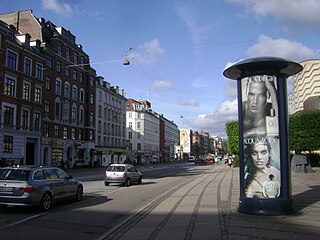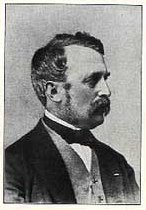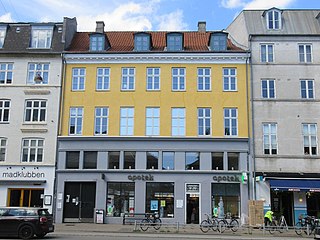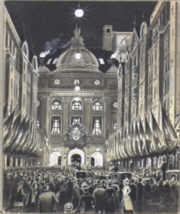
Vesterbro is one of the 15 administrative, statistical, and city tax districts (bydele) comprising the municipality of Copenhagen, Denmark. It covers an area of 3.76 km2 (1.45 sq mi), has a population of 51,466 and a population density of 13,688 per km².

Valby ( ) is one of the 10 official districts of Copenhagen Municipality, Denmark. It is in the southwestern corner of Copenhagen Municipality, and has a mixture of different types of housing. This includes apartment blocks, terraced housing, areas with single-family houses and allotments, plus the remaining part of the old Valby village, around which the district has formed, intermingled with past and present industrial sites.
Bent Mejding is a Danish actor, stage director and theatre manager. He won a Danish Film Academy Award in 1985 and 2007. He is married to the actress Susse Wold.

The Nørrebros Teater is a theater in Copenhagen, Denmark. Notable actors who have starred at the theatre before entering film include Osvald Helmuth, Buster Larsen, Poul Reichhardt and Poul Bundgaard. It is now operated as a part of the Københavns Teater in affiliation with the Betty Nansen Teatret, Folketeatret and Østre Gasværk Teater.
The following lists events that happened during 1908 in Denmark.

Vesterbrogade is the main shopping street of the Vesterbro district of Copenhagen, Denmark. The 1.5 km long street runs from the City Hall Square in the east to Pile Allé in Frederiksberg in the west where it turns into Roskildevej. On its way, it passes Copenhagen Central Station as well as the small triangular square Vesterbros Torv. It is one of four such -bro streets, the other being Nørrebrogade, Østerbrogade and Amagerbrogade.
Waage Sandø is a Danish theatre, film and television actor. He is known to international audiences mainly for his appearances in the TV series Bedrag

Viggo Lindstrøm was a Danish actor and theatre director, founder of Det Ny Teater in Copenhagen. He was married to the actress Vera Lindstrøm.
Viggo Hjalmar Wiehe was a Danish stage and film actor whose career spanned over five decades.
Københavns Teater, often referred to as kbht,, is a self-owning organization under the Danish Ministry of Culture responsible for sponsoring and managing a number of theatres in the Greater Copenhagen area. The theaters within the organization are managed by a board that decides which venues should be offered. The members of the Board of Directors are appointed from among persons affiliated with the acting industry.

Gammel Kongevej is the principal shopping street of Frederiksberg in Copenhagen, Denmark. Running roughly parallel to Frederiksberg Allé and Vesterbrogade, it extends from Vesterport station at the southern end of The Lakes and continues for some 1.8 km west to Frederiksberg City Hall Square where it continues as Smallegade. In the opposite end, Jernbanegade connects it to Copenhagen City Hall Square.

Tvedes Bryggeri was a brewery on Vesterbrogade in Copenhagen, Denmark. Founded by Hans Jørgen Tvede in 1852, it became the largest Nordic producer of small beer in the 1880s prior to its merger with several other breweries under the name De Forenede Bryggerier in 1891. Its buildings were converted into apartments in the 1990s. The two buildings that front the street are heritage listed.

National Scala was an entertainment venue opposite Tivoli Gardens on Vesterbrogade in Copenhagen, Denmark. The building was later converted into a shopping centre and demolished in 2013.
Hans Egede Budtz was a Danish stage and film actor.
The Reumert Award is an annual Danish awards ceremony to recognize excellence in theatre achievements in Denmark. The award was founded by the Bikuben Foundation in 1998, and has been handed annually since then. There are 16 award categories as well as 10 talent awards. A jury of ten specialists in theatre selects the recipients, who receive a statuette and a prize. As of 2016, the recipients also receive an amount of money. The recipients of the Reumert Award of Honour receive DKK 200,000, the recipients of the Talent Prize receive DKK 35,000 and all other categories-recipients receive DKK 40,000. The Reumert prize is named after the Danish actor Poul Reumert (1883–1968).

Harald Conrad Stilling was a Danish architect who was active in Copenhagen during the Late Classical period of the mid-18th century. He received the C. F. Hansen Medal in 1841.

Rogert Møller was a Danish architect and credit union manager. He was as an architect mainly active in the Vesterbro district of Copenhagen, designing many residential buildings during the population boom of the late 19th century. He worked for Østifternes Kreditforening from 1876 and served as chief technical officer from 1904.

Ingeborg Cathrine Caroline Skov (1893–1990) was a Danish actress who performed on stage as well as in a number of films. After training at Copenhagen's Dagmar Theatre, she made her stage debut there in 1911 while her first movie appearance was in 1914 in the silent film Elskovsbarnet. After marrying the theatre director Carl Thorvald Larsen in 1930, she performed a wide variety of key roles, first at the Odense Theatre until 1935 and thereafter at Copenhagen's Folketeatret until 1959. After her husband retired, she ran the Alexandra Cinema in Copenhagen.

Ellen Aggerholm née Abrahams (1882–1963) was a Danish stage and screen actress. She made her debut in Attester at Copenhagen's Folketeatret in 1901. In 1911, she moved to London where she first played Puck in Shakespeare's A Midsummer Night's Dream at Her Majesty's Theatre. She returned to Denmark when war broke out in 1914, touring with her husband's company until 1917. She then joined the Odense Theatre where she became the principal actress until 1924. She went on to tour the provinces until she performed in repertoire at the Casino Theatre in Copenhagen. After a long career, she retired from the stage in 1947. While young, Aggerholm performed a number of leading roles in mainly short silent films released by Nordisk Film from 1910 to 1915.

The Wegener House is a mid 19th-century building complex on Vesterbrogade in the Besterbro district of Copenhagen, Denmark. In the first half of the 19th century the property was the site of first James Price's summer theatre and then of Vesterbro Morskabsteater.The latter was replaced by the present building on the site in the late 1840s. The property was acquired by royal historian and archivist C.F. Wegener in 1856. In 1867, Wegener expanded the building with a new four-storey rear wing as well as a library building for his extensive private book collection. The rear wing and the library building are connected to each other by a first floor skywalk, The three buildings were listed in the Danish registry of protected buildings and places in 1981.


















